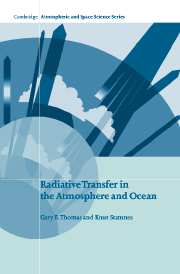Book contents
- Frontmatter
- Contents
- List of Illustrations
- Preface
- Acknowledgments
- Chapter 1 Basic Properties of Radiation, Atmospheres, and Oceans
- Chapter 2 Basic State Variables and the Radiative Transfer Equation
- Chapter 3 Basic Scattering Processes
- Chapter 4 Absorption by Solid, Aqueous, and Gaseous Media
- Chapter 5 Principles of Radiative Transfer
- Chapter 6 Formulation of Radiative Transfer Problems
- Chapter 7 Approximate Solutions of Prototype Problems
- Chapter 8 Accurate Numerical Solutions of Prototype Problems
- Chapter 9 Shortwave Radiative Transfer
- Chapter 10 Transmission in Spectrally Complex Media
- Chapter 11 Radiative Transfer in Nongray Media
- Chapter 12 The Role of Radiation in Climate
- Appendices
- Index
Chapter 5 - Principles of Radiative Transfer
Published online by Cambridge University Press: 18 December 2009
- Frontmatter
- Contents
- List of Illustrations
- Preface
- Acknowledgments
- Chapter 1 Basic Properties of Radiation, Atmospheres, and Oceans
- Chapter 2 Basic State Variables and the Radiative Transfer Equation
- Chapter 3 Basic Scattering Processes
- Chapter 4 Absorption by Solid, Aqueous, and Gaseous Media
- Chapter 5 Principles of Radiative Transfer
- Chapter 6 Formulation of Radiative Transfer Problems
- Chapter 7 Approximate Solutions of Prototype Problems
- Chapter 8 Accurate Numerical Solutions of Prototype Problems
- Chapter 9 Shortwave Radiative Transfer
- Chapter 10 Transmission in Spectrally Complex Media
- Chapter 11 Radiative Transfer in Nongray Media
- Chapter 12 The Role of Radiation in Climate
- Appendices
- Index
Summary
Introduction
The radiation field in atmospheres and oceans is affected by the presence of a bounding surface, such as that of a solid land material, a liquid, such as an ocean, or an effective surface, such as a dense cloud deck. Similarly, the radiation field in the ocean is determined by the transmission of direct and diffuse light through the ocean–atmosphere interface. (A “surface” in our usage can even be the outer “edges” of a gaseous medium.) In this chapter we define emissive and reflective properties of surfaces applicable to their longwave and shortwave interactions, respectively. Infrared surface properties are generally simpler than UV/visible properties, since reflection of IR radiation is usually unimportant. Furthermore, except at millimeter wavelengths, surfaces emit thermal radiation approximately isotropically. Descriptions of surface interactions have historically been largely empirical, but in the past several decades, physically based models of surface reflection have gained in popularity with the need (for example) to relate land reflectance to crop yield and ocean color to water fertility. Somewhat analogous quantities for aerosols, the single-scattering albedo a and phase function p, describe the probability for scattering and the angular dependence of the scattered light, respectively. With these specifications, the radiative transfer equation including both scattering and absorption can be easily written down. We derive a closed-form solution for the local thermodynamic equilibrium intensity for the limiting case of zero scattering. The formal solution for the general case then immediately follows, although because it is expressed in terms of the unknown source function, it is not yet a usable result.
- Type
- Chapter
- Information
- Radiative Transfer in the Atmosphere and Ocean , pp. 130 - 169Publisher: Cambridge University PressPrint publication year: 1999



